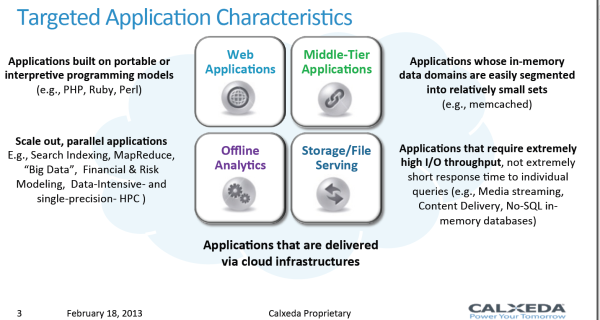Calxeda's ARM server tested
by Johan De Gelas on March 12, 2013 7:14 PM EST- Posted in
- IT Computing
- Arm
- Xeon
- Boston
- Calxeda
- server
- Enterprise CPUs
Finding a Good Fit
The previous benchmarks have shown that the first Calxeda server is not for the general IT market. As the slide below shows, Calxeda targets four kinds of workloads:
- Web applications
- Middle-tier applications
- Offline analytics
- Storage and file serving
For applications such as Memcache, the ECX-1000 1.4GHz lacks bandwidth and memory capacity. Once a Cortex-A15 based server is available, this can change quickly as performance will improve significantly and the amount of memory per CPU can be quadrupled to 16GB.
We did not test it yet, but our own experience tells us that the majority of the "scale out" applications are out of reach. Especially in the financial and risk modeling world, top performance and ultra low response times are prioritized.
Calxeda based Boston servers are already making inroads as storage servers. There is little doubt that a low power processing unit makes a lot of sense in a storage server.
That leaves the question whether or not Calxeda's latest server can make it in the web server and Content Delivery world. Calxeda claims 5W per server node, and no more than 250W for the complete server chassis with 24 server nodes. That's pretty cool, but currently there is another solution. Two octal-core Xeon E5 deliver no less 32 threads running on top of 16 very potent cores. Add a virtualization layer and you get tens of servers. The only limitation is typically the amount of RAM.
So assume you are a hosting provider. Which server do you use as your building block? You've got two choices:
The standard one, the Intel Xeon E5 server. The advantages are excellent performance whenever you need it, whether your application scales well with more threads or not. The Xeon can address up to 384GB of affordable RAM (16GB DIMMs). If that's not enough, 768GB is possible with more expensive LR-DIMMs.
Those are impressive specs, but what if most of your customers just want to host medium sized web sites, sites that are rich on content but rather low on processing requirements? Can the Boston Viridis server attract such users with a much lower power consumption? How far can you go with slicing and dicing the Xeon's monstruous performance into small virtual pieces? We decided to find out.











99 Comments
View All Comments
Madpacket - Wednesday, March 13, 2013 - link
And all of a sudden AMD's acquisition of SeaMicro is starting to make sense. Thanks Johan, great article!JohanAnandtech - Wednesday, March 13, 2013 - link
I really really hope they downscale the current SeaMicro's soon. Because with a starting price at $139000, they are not catering to the typical SME :-).joshv - Wednesday, March 13, 2013 - link
It seems this has a very narrow application in VM hosting, but I am not sure it's applicable when you have the choice of just scaling up memory or process usage of the single instance Xeon server. For example, I could load 24 instances of my production middle tier on the ARM server - or I could run one instance on a Xeon server and give it all the memory and make sure it spawns enough threads to keep all the internal cores busy. Perhaps my middle tier software has issues with handling all that RAM, so maybe I run 4 instances of it as a process, not a biggy.I am going to bet that the Xeon server will win as it won't have the VM overhead.
Kurge - Wednesday, March 13, 2013 - link
I would be interested in a bare metal comparison. Since you're serving up the same app why would you split it between 24 VMs on the Xeon server? It's a bit contrived.Just load up Server 2012 and IIS or Linux + Apache straight up on the Xeon and see how it performs.
MrSpadge - Wednesday, March 13, 2013 - link
Very interesting!I'd prefer a fat machine with virtualized servers to get automatic load balancing, but it's not like one couldn't shuffle tasks around in the ARM farm. And there's room for improvement: be it the next Atom or the memory controller in the current ECX-1000 CPUs. And take a look at how badly they scale from 2 to 4 threads - surely, there's lot's of rooms left!
rubyl - Wednesday, March 13, 2013 - link
What is the average CPU utilization for the Viridis nodes and for the Xeon system under the 5 different concurrency loads (for the 24 webserver workload)?gercho - Wednesday, March 13, 2013 - link
When you said " The next generation ARM servers are already on the way and will probably hit the market in the third quarter of this year. The "Midway" SoC is based on a 28nm (TSMC) Cortex-A15 chip. A 28nm A15 offers 50% higher single-threaded integer performance at slightly higher power levels and can address up to 16GB of RAM." As far as I know the A15 cores have 50% more performance but consume 3X more power, that's not "slightly".........nofumble62 - Wednesday, March 13, 2013 - link
50% more performance at 3X more power... reminding me of the Netburst architect.thenewguy617 - Wednesday, March 13, 2013 - link
Can you please point me to sources of your number?Thanks
Wilco1 - Thursday, March 14, 2013 - link
Where on earth you do get that 3x from? So far no 28nm Cortex-A15 chips have been released. The A15 in the Exynos Octo uses about 1.25W per core at 1.8GHz according to Samsung. That's slightly more power than a Calxeda A9 uses per core, but the A15 gives twice the performance per core.